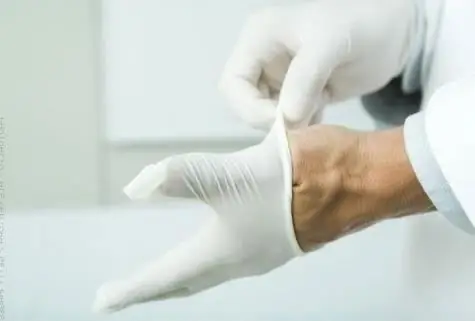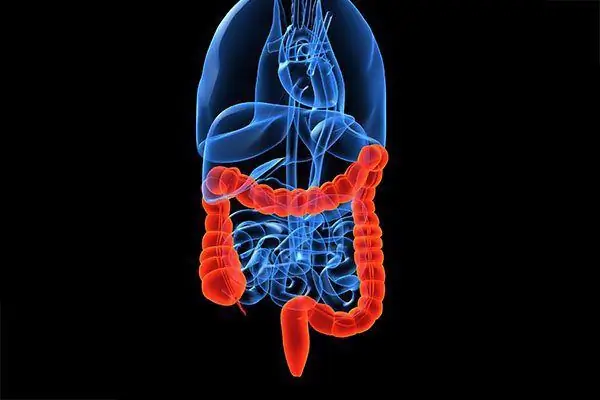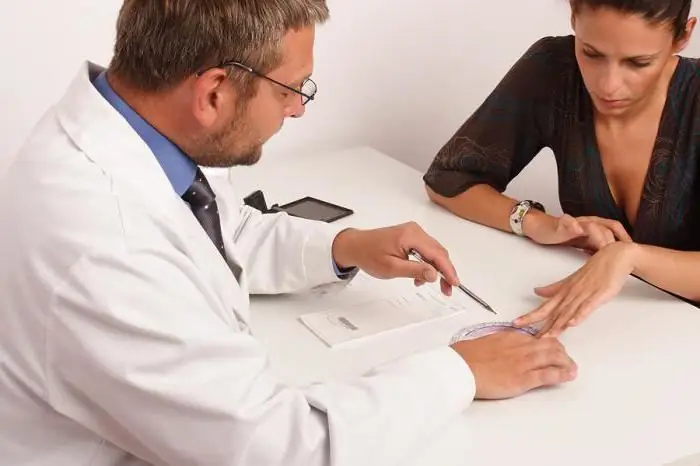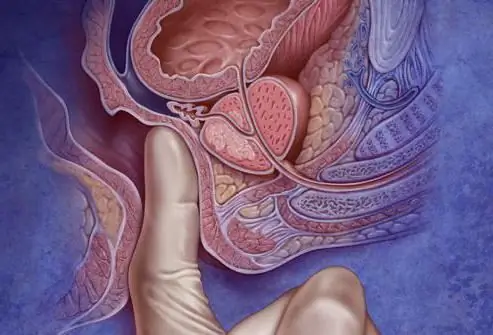- Author Curtis Blomfield [email protected].
- Public 2023-12-16 20:44.
- Last modified 2025-01-23 17:01.
Rectal examination is part of the mandatory annual check-ups. Most patients are afraid of this manipulation and make them move the time of visiting specialists further away, under the pretext that the absence of complaints indicates a good level of he alth. Rectal examination of the rectum is used in gynecology, proctology, urology, surgery and allows you to determine the presence of pathological conditions of neighboring organs.

Types of examinations
They use the method of finger research, as well as instrumental, during which rectal mirrors and a sigmoidoscope are involved. The finger method allows you to assess the condition of the pelvic organs in women, the prostate gland in men and the abdominal organs.
Digital rectal examinationcarried out every time during the medical examination, the appearance of abdominal pain, disorders of the intestinal tract and organs of the reproductive system. This method is used before each instrumental examination to check the patency of the rectum, avoiding further complications.
Instrumental rectal examination is carried out in order to assess the condition of the intestinal tract, the rectum. It allows you to determine the presence of inflammatory processes, polyps and neoplasms, obstruction, strictures.
Indications for conduction
Such manipulation is carried out in the following cases:
- pathology of the rectum (infiltration, the presence of ulceration, narrowing, compression of the walls by neoplasms);
- paraproctitis - inflammation of the pelvic tissue;
- peritonitis;
- assessment of the performance of the sphincter;
- determination of pathologies of the coccyx, Bartholin and Cooper glands;
- diseases and neoplasms of the prostate gland;
- inflammatory processes, the presence of tumors of the female reproductive organs;
- for diagnostic purposes.

Rectal examination in proctology
Before the manipulation, the doctor examines the anus. The presence of hyperemia, maceration, inflammatory processes, pathological secretions, external hemorrhoids is determined. Next, the patient takes one of the positions:
- on the side with the knees brought to the chest;
- knee-elbow posture;
- lying on a gynecological chair, and legs bent at the knees and pressed to the stomach.
How the procedure works
Digital rectal examination does not require prior preparation of the patient. It is enough that after the last bowel movement the patient takes a shower and performs hygienic treatment of the genitals and the anus. The algorithm of the procedure is as follows:
- The patient takes one of the positions (at the request of the specialist, she changes during the manipulation).
- Doctor cleans hands and puts on gloves.
- Vaseline oil is applied to the index finger and anal area.
- With a gentle slow movement, a finger is inserted along the back wall of the intestine to a depth of 5 cm.
- During the examination, the doctor may ask you to tighten or relax the sphincter.
- The finger is removed. There should not be any pathological secretions (mucus, blood streaks, pus) on the glove.

Rectal speculum examination
Let's consider how the examination of the rectum is carried out using medical instruments. After the digital method, the rectal mirrors in the area of the branches are lubricated with vaseline oil. The anus area is treated in the same way.
The patient takes a knee-elbow position. The branches are introduced into the rectum by 8-10 cm, moved apart and slowly removed, in parallel examining the intestinal mucosa. The same principle is used in the vaginal gynecological examination of women.
Sigmoidoscopy
Thisendoscopic method for diagnosing the condition of the sigmoid and rectum. The examination is carried out using a sigmoidoscope. The device is inserted into the rectum, the patient is in the knee-elbow position. With the help of the lighting device, which is part of the device, and the optical system, you can examine the mucous membrane for 30 cm.

The picture of the examined area is displayed on the monitor screen, where the doctor with an assistant can assess the presence of an inflammatory process, tumors, polyps, internal hemorrhoids, cracks.
Indications for:
- presence of pathological discharge;
- false urge to defecate;
- hemorrhoids;
- discomfort in the rectal area;
- suspected neoplasm;
- colitis.
Contraindications for sigmoidoscopy:
- acute peritonitis;
- acute inflammatory processes of the rectum;
- General serious condition of the subject.
Highly specialized institutions
Proctology Center is one of the specialized medical and diagnostic institutions, where rectal examination is a mandatory procedure for examining patients. Any diagnostic and some therapeutic manipulations take place immediately after assessing the condition of the rectum.
Proctological Center - an institution whose specialists are engaged in the differentiation of pathology, the development of comprehensive programs for the treatment of patients usingmedical, surgical and physiotherapeutic methods of treatment.

Here they deal with such states as:
- hemorrhoids;
- inflammatory processes of the rectum and colon, fiber, anorectal region;
- sphincter failure;
- removal of foreign bodies;
- worm infestations;
- congenital pathologies of the anorectal region;
- strictures and atresias of the rectum;
- injuries;
- fistula;
- tumor processes;
- rectal prolapse.
Rectal examination of the prostate
In the field of urology, examination of the prostate through the rectum is a must for all men over 40 years of age. This method allows you to recognize the presence of pathologies at the initial stages. The finger method is used. Before it is carried out, it is necessary to explain to the patient the purpose of the diagnosis in order to avoid tension and a negative reaction.
Rectal examination of the prostate allows you to evaluate the following indicators:
- size and shape;
- density and elasticity;
- clarity of contours;
- symmetrical lobules;
- presence or absence of pain;
- presence of scars, cysts, stones on the surface;
- condition of seminal vesicles;
- motility of the gland;
- the condition of the lymph nodes, their size, mobility, elasticity.

Normal readings are as follows:
- The gland has two symmetrical lobules separated by a groove.
- Dimensions (in cm) - 2, 5-3, 5 x 2, 5-3.
- Round body shape.
- No pain on palpation.
- Clear contours.
- Tight elastic consistency.
- Smooth surface.
- Seminal vesicles are not palpable.
Rectal examination in gynecology
In this area of medicine, a rectal examination is performed by a gynecologist, not a proctologist. Let's take a closer look at how women are examined and why it is carried out.
Examination using the finger method is necessary in the following cases:
- assessment of the state of the pelvic organs in girls who have not had a sexual life;
- in the presence of atresia (fusion of the walls) or stenosis (narrowing) of the vagina;
- as an additional survey of the prevalence of the tumor process, if it is established;
- in the presence of inflammatory diseases, to assess the condition of ligaments, fiber;
- with parametrization;
- as part of a bimanual examination.
Since the proctologist does not participate in this manipulation, how women are examined and in what cases it is necessary, the attending gynecologist decides. During the procedure, you can clearly assess the condition of the cervix, the presence of cicatricial changes, fluid accumulation. In addition, a specialist can determine the presence of pathological changes in the rectum itself, which have arisen against the background of gynecological diseases ortumor compression.
Examination of women in labor
Rectal examination can be used to re-monitor women in labor. You can determine the degree of disclosure of the cervix, the presentation of the child, the condition of the amniotic sac and its integrity, the location of the sutures and fontanelles of the baby (this item is not in all cases).

Before the procedure, the woman must empty her bladder. Lie on your back, bend your legs at the knees and spread apart. The woman in labor should breathe absolutely calmly in order to relax the muscles as much as possible. Several diagnostic methods are used:
- Finger - with one finger, thickly lubricated with vaseline oil, the necessary indicators are evaluated.
- Rectovaginal - the index finger is inserted into the vagina, and the middle finger into the rectum. The second hand examines the reproductive organs of a woman through the abdominal wall.
Rectovaginal examination can also be done in several ways. Sometimes it is necessary to insert the index fingers of both hands: one into the vagina, the other into the rectum. In order to study the state of the vesicouterine space, it is possible to insert the thumb into the vagina, and the index finger rectally.
Conclusion
Rectal examination is a reliable and informative method for the initial assessment of the patient's condition. This method is affordable and allows you to obtain additional data on the patient's he alth level.






